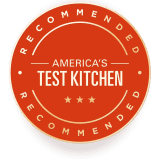The Best 13 by 9-Inch Baking Pans/Dishes
Equipment Review
Making bakery-quality sandwich breads and pound cakes at home isn't hard. You just need the right loaf pan.
Published Dec. 1, 2018. Appears in America's Test Kitchen TV Season 21: Elegant French Desserts

Loaf pans give baked goods a distinctive tall, rectangular shape that would be impossible to achieve with any other piece of equipment. They're a must-have for zucchini and banana breads, sandwich loaves, and pound cake. We also use loaf pans for more intricate baked goods, such as brioche, babka, and flan, and for small lasagnas.
A decade ago, the Williams Sonoma Goldtouch Nonstick Loaf Pan, 1 lb ($22.95) won our testing of loaf pans. Its internal dimensions are 8½ by 4½ inches at the top of the pan, about ½ inch smaller in each direction than a classic loaf pan. It sounds negligible, but the narrower dimensions result in loaves that rise slightly higher and have taller, prettier domes. (Pans of both sizes can hold about 1 pound of dough and are sometimes labeled that way.) After years of use in the test kitchen, our winner continues to impress us by baking foods evenly and releasing them cleanly. There's just one hang-up: Its corners have little crevices that trap food and are a nuisance to clean.
We resurveyed the market and were pleased to see more options in the smaller size we prefer. We purchased 10 pans, priced from $7.53 to $24.95. Most were made from metal or silicone and marketed as 8½ by 4½ inches. We couldn't find any glass pans in those dimensions and were curious about how the material performed, so we included two that were the right length but slightly wider. Then it was time to start baking.
We baked three foods in each pan: sandwich bread, pound cake, and mini lasagna. All the pans released food easily. However, we did see some subtle differences in overall browning, particularly with the breads and cakes. They varied from golden brown to darker brown, but all were acceptable.
The pans were generally easy to maneuver, too. Those with handles felt more secure, but even a simple rolled edge offered enough room to grip. With good performance and maneuverability across the board, we focused on aesthetics, paying particular attention to the breads and cakes, where we saw clear differences. Our preferences came down to two factors: size and shape.
Pan size affects the shapes of baked goods. If the pan is too small, the batter or dough can overflow more easily. One pan produced a pound cake that almost overflowed and mushroom-shaped sandwich bread with a bulbous top that rose up and out; the exposed edges on both burned. Several other pans produced noticeably wider loaves that looked comparatively chubby and squat. Our favorite pans created cakes and breads that rose straight up and had rounded tops that didn't slump or spill over the sides. They looked like something s...

The mission of America’s Test Kitchen Reviews is to find the best equipment and ingredients for the home cook through rigorous, hands-on testing. We stand behind our winners so much that we even put our seal of approval on them.

Kate is a deputy editor for ATK Reviews. She's a culinary school graduate and former line cook and cheesemonger.
This is a members' feature.
0 Comments